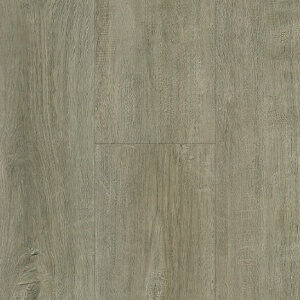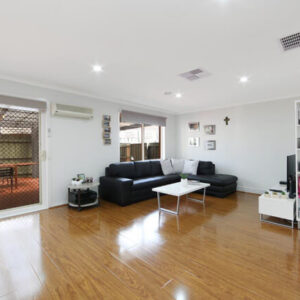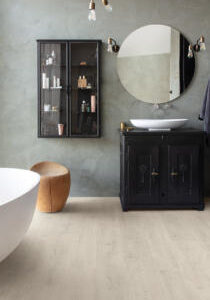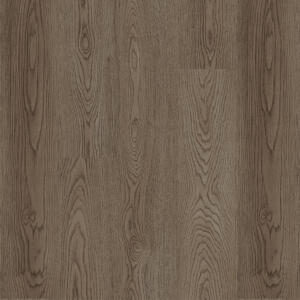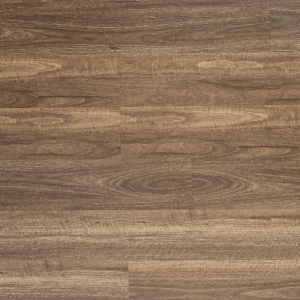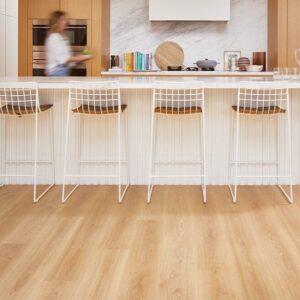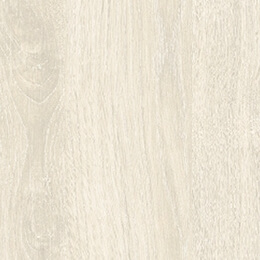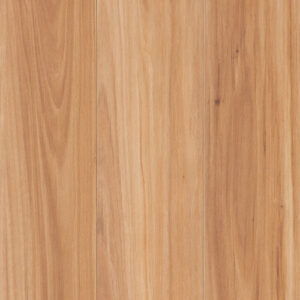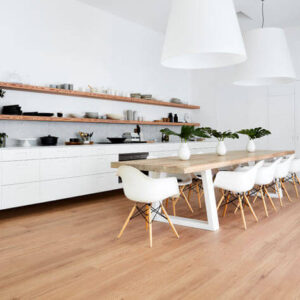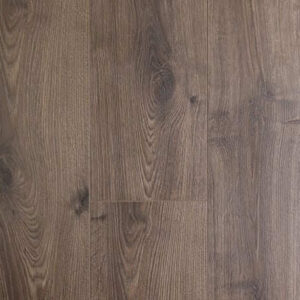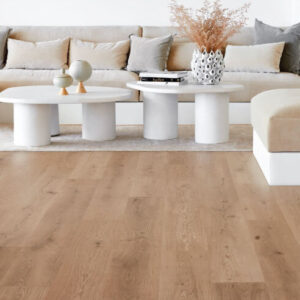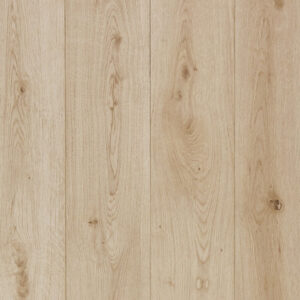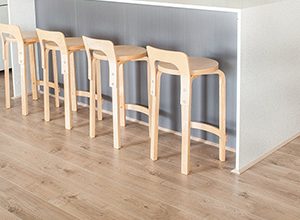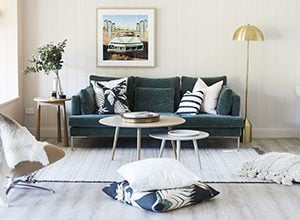Waterproof Laminate flooring for sale in Melbourne
Laminate flooring is a multi-layer synthetic flooring product bonded together with a lamination method. Laminate floors can be made to mimic wood or stone with a graphical (for decorative purposes) layer placed under a clear shielding layer. The inner core sheets are typically melamine resin and fiberboard materials. Following are the various types and styles of waterproof Laminate Floors available. Mikes Carpet aims to provide stylish and high-quality floorings to all its customers in Melbourne and other cities in Australia.
Types of laminates
Over the years, It has proven itself a state-of-the-art yet affordable substitute for typical hardwood flooring.
Laminate flooring is a viable solution that offers realistic wood and stone appearances in extremely durable substructures while being one of the most cost-effective options in today’s market. It all started when laminate first appeared as an answer to natural hardwood back in the 1970s – bringing low-maintenance cleaning routines with it ever since!
Laminate flooring may be the perfect solution if you’re looking to upgrade your current flooring and add value to your home.
As a low-maintenance alternative with all of the aesthetic benefits of wood floors – plus superior durability and water resistance – it’s no wonder why this trend is taking over!
This guide will ensure clarity when steering through the buying process, so there’s no need to fret: let us help make your dream living space come to life without breaking the bank!
Why Use Laminate Flooring?
Laminate flooring is a great way to add style and functionality to your home. It’s available in various styles, colors, and textures so that you can find the perfect match for your space. But beyond its aesthetic appeal, it also offers excellent practical benefits.
Let’s take a look at some of the Pros and Cons that laminate flooring has to offer.
Pros of Laminate Flooring
Durable: Laminate flooring’s superior durability makes it an excellent option for high-traffic areas or homes with kids and pets. In addition, it holds up well against wear and tear, so it won’t need to be replaced as often as other types of flooring. This means you can enjoy your laminate floors for many years before needing to replace them.
More scratch resistant than vinyl: Laminate has a robust wear layer that protects the floor from scratches, indent, wear, and staining—all things that pets love to test our floors on! You can rest easy knowing that your laminate floors won’t suffer any damage from pet claws or toys.
Realistic wood and stone look: Laminate floor planks often have some surface detail to further mimic a natural hardwood look and can have the look and feel of a hand-scraped hardwood, embossed wood, distressed hardwood, or come in textured or smooth. Unlike natural hardwood, you’ll see consistent quality across all laminate flooring boards.
Can resist some water: Advances in construction are improving laminate’s water-resistant capabilities. While it’s still not as water-resistant as ceramic tile or vinyl plank flooring, most laminates can handle spills without damage—so long as they are cleaned promptly!
Affordable: Laminate flooring is one of the most affordable hardwood flooring available today. Not only does it cost less than other hardwood floorings, but it’s also easier to install because it’s designed for DIY installation, so you can save money on labor costs.
Durability: Laminate floors are incredibly durable and can withstand heavy foot traffic and everyday wear and tear. The top layer of the laminate also helps protect against stains, scratches, fading, and scuffs. This makes laminate floors great for busy households with children or pets.
Can Be Installed Over Radiant Heating Systems: You won’t find this feature with most hardwood flooring options. However, laminate floors can be installed over radiant heating systems without the risk of damage or warping due to temperature changes in the home. This makes them ideal for homes with already installed radiant heating systems, or you may consider adding one in the future!
Accessible To Clean & Maintain: One of the best features of laminate floors is how easy they are to clean and maintain with regular sweeping or mopping as needed – no need for any special cleaners or waxes! Plus, unlike solid wood planks, which require periodic sanding and refinishing as needed over time, laminate floors never need refinishing since their surfaces are not porous like solid wood planks.
Easy To Install: Laminate flooring is designed to be installed as a floating floor, meaning it floats through an interlocking design.
When looking for durable yet stylish flooring solutions for your home, consider the pros of investing in laminate floors! It is available in various styles and colors and offers great practical benefits, such as being incredibly durable and more scratch resistant than vinyl.
Its realistic wood and stone looks will give any room an elegant touch without breaking the bank! With its new water-resistant capabilities, you don’t have to worry about spills ruining your beautiful new floors either – make sure you clean them up quickly! All in all, investing in laminate will be sure to give you years of satisfaction!
Cons of Laminate Flooring
Laminate flooring is a popular and attractive type with many benefits, including being easy to install and maintain. However, before deciding, it’s essential to be informed of the potential drawbacks.
Not as Water-Resistant as Vinyl:
While laminate flooring is more water-resistant than traditional hardwood floors, it still cannot tolerate standing pools of water. Therefore, if you have moisture issues with your subfloor, you will need to install a vapor barrier in addition to the laminate flooring. Additionally, you live in an area that experiences extreme weather conditions, such as frigid winters or hot summers.
Not Recommended for Wet Areas:
Laminate flooring is not recommended for full bathrooms or basements since these areas are prone to leaks and flooding. You can make your laminate floor more water-resistant by installing a waterproof underlayment, but this isn’t foolproof and won’t guarantee protection from liquid damage. For wet areas like bathrooms and basements, vinyl or tile are better options since they are more resistant to water damage.
Can Be Easily Damaged/Scratched:
Laminate flooring can be easily scratched or damaged due to its thin protective wear layer on top of the image layer below it. While certain products available can help make your laminate floor more scratch-resistant, they still aren’t unbreakable and should be handled with care.
How To Choose Laminate Flooring
Laminate flooring is a popular choice among homeowners, businesses, and apartment complexes alike due to its stylish versatility – plus, it stands up well in high-traffic areas. Some factors that you should keep in mind when choosing to floor:
Your budget is one of the first things to consider when selecting laminate flooring. Laminate flooring can range from very cheap to surprisingly expensive, so figure out what you’re willing to spend before shopping.
-
- Check Out Different Styles and Colours
The beauty of laminate flooring is that it comes in various styles and colors, so take some time to browse your options. Consider which type best complements your existing decor or which color would make your room pop. If you need help, ask a local hardware store salesperson for advice on what might work best for you.
-
- Think About Durability and Maintenance
Laminate flooring is known for its durability; however, some types are more durable than others. For example, while thinner laminates are often cheaper, they won’t be able to withstand daily wear and tear over time as thicker laminates will. Additionally, some laminates require more maintenance than others — such as regular waxing or polishing — so be sure to factor this into your decision-making process.
- When choosing laminate for residential or commercial applications, the AC rating of each product plays an important role; this number reflects how durable it will be with heavy footfall and wear over time.
- Those seeking out floors that can handle lots of activity should opt for laminates with higher AC ratings (e.g. 4 or 5), while homes may favor products rated 1 through 3 on the scale instead.
Residential Laminate Flooring
- Residential laminate flooring is an increasingly popular choice for homeowners due to its durability, affordability, and wide array of styles and finishes.
- This type of flooring is extremely durable and resistant to scratches, stains, and fading from exposure to sunlight. It is also easy to maintain with regular sweeping or vacuuming.
- Moreover, residential laminate flooring is affordable compared to other options like hardwood or stone.
- Whether you are looking for a wood-like finish, a ceramic tile look, or something in between, there’s sure to be a style that meets your aesthetic needs.
With so many benefits and advantages of residential laminate flooring, it’s no wonder it continues to be a popular choice among homeowners!
Commercial Laminate Flooring
Commercial laminate flooring offers many advantages for a wide variety of spaces.
- It is durable, water-resistant, and easy to install and maintain.
- Additionally, its “floating floor” installation makes it the perfect choice for frequently reconstructed areas; the panels are easy to remove and replace with minimal effort.
- The stain-resistant surface of commercial laminate also makes it suitable for high-traffic areas and specific business environments where spills occur daily.
- Carbonised laminate provides excellent scratch resistance than standard laminates and can often be used in retail boutiques or commercial office spaces. With its numerous style options and relatively low cost, commercial laminate flooring is an excellent choice for almost any building application imaginable.
Laminate Flooring Construction
Laminate flooring is becoming an increasingly popular choice for homeowners, but what exactly is laminate flooring, and what are its features?
- Laminate flooring is constructed from four layers. The bottom layer is the backing layer, which provides stability and cushioning. It also helps reduce sound.
- The middle layer is the core layer, which consists mainly of high-density fiberboard (HDF) or medium-density fiberboard (MDF). This layer gives the laminate planks their strength and rigidity.
- The third layer, called the decorative layer, gives each plank its unique look and feel.
- A top wear layer protects your laminate floor from scratches and other damage.
- The core layers are made up of HDF or MDF boards fused under intense pressure and temperature in a process known as “high-pressure lamination” (HPL). This process ensures that the planks remain durable even under high foot traffic.
- Furthermore, this process locks in the colors, so they do not fade over time due to exposure to sunlight or water spills.
- The decorative layers are printed with a digital image of authentic wood grain patterns or stone textures to give it a realistic look and feel without compromising quality or performance.
- These images are then sealed with an extra protective coating to ensure they last longer than traditional hardwood floors or stone tiles.
- Additionally, this coating makes it easy to clean spillages off your laminate floor with a damp mop or cloth without damaging it!
- At first glance, laminate flooring may appear relatively straightforward, but a lot is happening behind the scenes! By understanding how laminate flooring is constructed, you can make an informed decision about whether it’s right for you based on your needs, budget, lifestyle, and preferences.
- Ultimately, choosing laminate will provide you with a beautiful, strong, and practical floor! If you’re considering installing new floors in your home soon, then make sure you explore all your options carefully, including looking into laminate flooring for yourself!
Laminate Flooring Health & Safety
When adorning your home with a laminate floor, you want to be sure your family isn’t breathing in damaging toxins. Laminate flooring’s health effects have caused some concern over the years after a “60 Minutes” report indicated possibly higher concentrations of formaldehyde than regulated by California standards.
Formaldehyde is present naturally in our environment and has been used in multiple household products throughout the years, but it’s not necessarily safe or dangerous – just complicated.
To reduce potential inhalation or exposure, ensure you’re purchasing quality-tested laminate flooring and not skimping on safety. In addition, keep an eye out for specific certifications, such as CARB2 certification, which provides air quality compliance.; such certificates give peace of mind that the product obtained is free from hazardous chemicals.
How to Install Laminate Flooring
Laminate flooring is affordable and is a relatively simple task that most people can do with just a few essential tools.
Preparing the Room for Installation
The first step in installing laminate flooring is to prepare the room for installation. This involves removing existing carpets or floor coverings, such as rugs or linoleum.
Any furniture in the room should also be moved out of the way.
Once the room is empty, it’s time to start laying down the underlayment, which provides additional cushion and insulation against sound and moisture.
The underlayment should be laid down in strips across the room’s entire length, ensuring that all seams are appropriately aligned.
Installing the Laminate Flooring
- Once the underlayment has been laid down, it’s time to start installing the laminate planks. Start by laying down one row at a time, ensuring each plank is securely attached to its neighbor using locking mechanisms on either end.
- Make sure that all seams are tightly sealed as well; this will help prevent water from seeping between planks and causing damage over time. As you install each row, stagger them so that no two ends meet up in a single line; this will create a more uniform look for your finished product.
- It’s also essential to leave a gap of about ¼ inch around all walls for the laminate to expand and contract naturally due to temperature changes.
Finishing Touches
- Once all your planks have been installed and secured, it’s time for some finishing touches! To get an even cleaner look, use quarter-round moldings along any edges where you left gaps for expansion purposes.
- This will give your new laminate flooring an extra polished look while also helping protect against any potential water damage along those edges.
- Additionally, seal any seams between planks with silicone caulk or another waterproof sealant; this will ensure that not even a drop of moisture can seep through those areas over time and cause damage to your beautiful new floors!
Installing laminate flooring can seem intimidating, but with our step-by-step guide, you can easily handle it yourself! As long as you prepare your room beforehand and follow our instructions carefully when laying down each plank, you’ll have beautiful new floors in no time! Furthermore, with proper maintenance, these floors can last for many years – giving your home an updated look without breaking the bank!
How to Clean Laminate Flooring
Clean up spills ASAP! This is one of the most important rules for keeping your laminate floor looking new. Spills left on the floor can seep into the seams of the planks, leading to warping and discoloration. To prevent this from happening, clean up any spills as soon as possible!
Regularly sweep up any dust, dirt, or debris, or use a vacuum with the hard floor attachment. Regular sweeping or vacuuming will help keep your laminate floors looking great by removing any dirt or debris that has been tracked in. If using a vacuum, make sure to use one with a hard-floor setting, so you don’t damage your floors.
Use a damp cloth to blot up spills. When cleaning up a spill on your laminate floors, avoid using too much liquid or water. Instead, use a wet cloth to gently blot up any spills and dry off any remaining moisture with a towel. Be sure not to scrub too hard or use too much pressure when cleaning – this could damage the protective coating on your laminate floors.
Regularly clean the floor with cleaning products made specifically for laminate floor care. Over time, dirt and grime can build up on your laminate floors, making them look dull and dingy. To refresh them periodically, invest in cleaning products designed specifically for laminates – these products will help keep your feet looking shiny and new!
Avoid washing or wet mopping the floor with soap, water, oil-soap detergent, or an ammonia-based cleaner since these can damage your floors over time due to their high pH levels.
For more details, log on to contactus@mikescarpets.com.au or call us at 1300 365 887.






